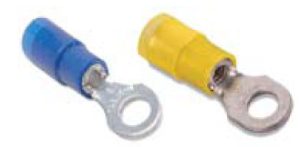
Ring terminals offer a simple and effective way to connect electrical wires to circuit points. Also known as ring connectors, they are characterized by the use of a ring-shaped conductive stud. After securing an electrical wire to the opposite end, you can connect the conductive stud to a circuit point.
Insulated vs Non-Insulated
There are insulated ring terminals, and there are non-insulated ring terminals. They both feature a sleeve-like opening on one end and a ring-shaped conducive stud on the other end. The difference is that insulated ring terminals have a layer of insulation — typically nylon, silicone or vinyl — over the sleeve.
Gauge Range
You should consider the supported gauge range when choosing ring terminals. Gauge refers to the thickness of a wire or cable. The thicker the wire or cable, the higher its gauge will be.
Most ring terminals are designed for wires within a specific gauge range. Some of them are designed for 16 to 22 gauge wire. Other ring terminals are designed for 10 to 12 gauge wire. Regardless, make sure you choose ring terminals in the right gauge range for the wires with which you intend to use them.
Installation Method
Not all ring terminals require the same installation method. To install a ring terminal, you’ll have to connect a wire to the end with the sleeve-like opening. Depending on the specific type of ring terminal, you may have to crimp the wire, or you may have to solder the wire.
There are crimp-style ring connectors that require crimping to install. After placing the wire through the sleeve-like opening, you can use a crimping tool to secure it in place. Other ring connectors require soldering. Soldering involves the use of heated filler material. Using a soldering iron, you can melt the filler material — known as solder — over the wire and ring terminal.
Color-Coded
You may notice that some ring terminals are color-coded. They feature an insulation sleeve in a specific color. Common colors for ring terminals include yellow, blue and red. What do these colors mean exactly?
Ring terminal colors represent their size, which of course determines their supported gauge range. Yellow ring terminals are bigger than blue ring terminals, so they support thicker wire with a lower gauge than their blue counterparts.
In Conclusion
Choosing the right ring terminals is important. Since they are used in electrical applications, you shouldn’t choose the first ring terminals that you come across. Instead, follow the tips outlined here to choose the right terminals.



